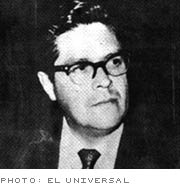|
In
1940 at the age of 22, Guillermo Gonzalez Camarena obtained US Patent
Gonzalez Camarena was born in Guadalajara, Jalisco, Mexico, in 1917. In 1932, after two years of studies, he left the mechanical-electrical engineering program at the National Polytechnic Institute to work as an operator at the radio station of his country’s Department of Public Education.
In 1934 he built his first monochromatic television camera from scrap materials he got from flea markets. After his US patent for the color television on August 19, 1940, he registered his invention at the Mexican Office of Patents and Trademarks, No. 10,235, thus protecting himself against plagiarism and prohibited use of his invention in his country. He immediately went to work, as chief operator, to the radio stations XEW and XEQ in the Mexican capital. In 1942 he began experimenting with television transmissions from his home, and in 1946 he founded XEGC, the first experimental television station in Mexico, with only two receptors built and installed by himself; one in XEW and the other in the Mexican League of Radio Experimenters.
In 1948 he established Gon-Com Laboratories to manufacture TV transmission equipment, which he succeeded in exporting to the US two years later. That same year he invented the first remote control in Mexico, showcased at the Presidential Objective Exposition that took place in the center of the city. Of specific importance is the first black and white transmission of a surgical procedure by closed circuit television during the 7th Assembly of Surgeons, an experience that was repeated the following year during the same Assembly, but this time in full color. In 1950, he obtained the right to commercialize Channel 5 in Mexico with the acronym XHGC, where two years later he began operations on May 10th with a Mother’s Day festival; but it wasn’t until August 18th that he began regular broadcasts.
In 1960, Gonzalez Camarena obtained in Mexico and in the US patents for his “Kaleidoscope”, an innovative color television system that was later improved and protected under a new patent in 1962 as the “simplified bi-color.” In 1963, XHGC began the first commercial color transmissions, broadcast to televisions in ten shopping centers in Mexico City, where the general public could enjoy them for free. Unfortunately, in 1965 Gonzalez Camarena died in a tragic automobile accident. This brilliant Latin American, without even reaching the age of 50 and working entirely in his own country of Mexico, managed to excel in a field traditionally reserved for scientists in first world countries. Guillermo González Camarena, an example of the best of the latin spirit. |
|
|
 Can
the inventor of the first color television be Latin American?
Can
the inventor of the first color television be Latin American?